NOTE: In 2011, I started scanning one of my own copies of this volume. As of January 2013, when David Armstrong / Sevanti Letterpress released their digitization (q.v.) , I had not yet finished. I'll leave online what I've done so far, since I have been scanning at a slightly higher resolution (600dpi), but, really, unless you have a specific need for this you should just get the Armstrong/Sevanti reprint. I may or may not finish this scanning project, depending on other committments. It is obviously no longer at the head of the scanning queue.
The 1923 American Type Founders Specimen Book and Catalog was the last comprehensive specimen book that ATF ever issued, and very nearly the last truly large specimen book ever issued by an American foundry.
There are some projects that need very much to be done... but nobody seems to do them. Putting the 1923 ATF specimen book online is such a project. There is one online version at present (2012), but it was scanned as a part of project to gather texts for OCR and, consequently, it represents the primarily visual information of this specimen very poorly. There is currently no online copy which is of sufficient image quality to satisfy the needs of the student of type. Yet this is without question the most important American type specimen book of the 20th century. So I'm just going to have to scan it myself.
This specimen book is a marvel of the printers' and typefounders' arts, and it deserves a fine digital edition. This is not that edition. It is a "quick and dirty" scan of the volume. But it is a scan in color at 600dpi. If you don't like this presentation, please take the data and make a better one!
This book is way too big to do as a single PDF and still retain sufficient resolution (with 2012 computer and network technology, at least). So I've split it up into sections of contiguous pages. The "sections" here are ones that I've invented for this digital version. The original volume does not identify them as such.
Note that the icons below are links to PDF versions of the sections - and that these PDFs are often quite large. If you just click on them, there is a very good chance that the PDF viewer used by your browser will simply crash (often they have an invisibly configured maximum file size). You should download these PDFs to your computer and view them offline.
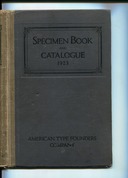
Front Binding
Spine. Front cover. Front pastedown. Front flyleaf, recto and verso.
In the unlikely event any future bibliographer should care, the front flyleaf verso is scanned from a different copy because in my disbound copy it was defaced with (not very interesting) notes in an old hand. (44 Megabytes)

1 - 16f: Front Matter
Catalog serialization page and colophon. Copyright page. Title page. Frontispiece (Central Plant, with staff). Preface (pp. 5-16). List of selling houses and agents (p. 16a). Policy of the Company (p. 16b). Officers and another view of the Central Plant (p. 16c). Ready Reference Index of The More Important Items (p. 16d). Section heading: Types (p. 16e). [blank] (p. 16f). (162 Megabytes)
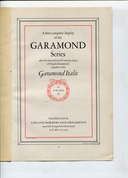
17-31: Garamond Family
Garamond. Garamond Italic. Garamond Bold. Cleland Borders and Ornaments. (152 Megabytes)
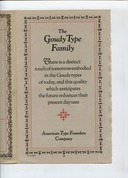
32-51: Goudy Type Family
Goudy Catalogue. Goudy Catalogue Italic. Goudy Oldstyle. Goudy [Oldstyle] Italic. Goudy Cursive. Goudy Title. Goudy Bold. Goudy Bold Italic. Goudy Handtooled. Goudy Handtooled Italic. (200 Megabytes)
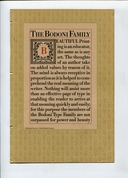
52-65: Bodoni Family
Bodoni. Bodoni Italic. Bodoni Book. Bodoni Book Italic. Bodoni Bold. Bodoni Bold Italic. Card Bodoni. Card Bodoni Bold. (106 Megabytes)
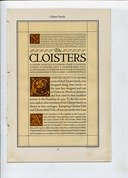
66-81: Cloister Family
Cloister Oldstyle. Cloister Italic. Cloister Cursive. Cloister Title. Cloister Bold Title. Cloister Bold. Cloister Bold Italic. Cloister Bold Condensed. [Classic Cloister Initials not fully shown.] (134 Megabytes)
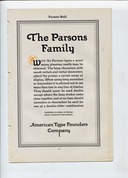
82-89: Parsons Family
Parsons. Parsons Bold. Parsons Italic. Parsons Auxiliaries (Swash Initials, Initial Decorators) (55 Megabytes)
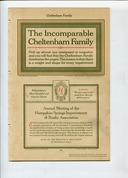
96-129: Cheltenham Family
Cheltenham Oldstyle. Cheltenham Italic. Cheltenham Medium. Cheltenham Medium Italic (Non-Kerning). Cheltenham Wide. Cheltenham Oldstyle Condensed. Cheltenham Medium Expanded. Cheltenham Medium Condensed. Cheltenham Bold. Cheltenham Bold Italic. Cheltenham Bold Condensed. Cheltenham Bold Condensed Italic. Cheltenham Bold Extended. Cheltenham Extrabold. Cheltenham Bold Extra Condensed. Cheltenham Bold Extra Condensed Title. Cheltenham Inline Extra Condensed Cheltenham Inline. Cheltenham Inline Extended. Cheltenham Bold Outline. (238 Megabytes)
See also: 429-443 (Shaded Faces), 586-621 (Typographic Accessories).
The ATF Caslon offerings are quite complex. They do not constitute a "family" of typefaces in the modern sense. Rather, they're an assemblage of various Caslon-ish typefaces for the most part inherited from various other foundries. (These include five different series each of which with some legitimacy may be called simply "Caslon" in regular weight and width.) Note, however, that even the inherited faces would by this time have been reworked for standard lining by L.B. and M.F. Benton - a nontrivial task.
The 1923 Specimen generally groups the various Caslons by their origins. Following these divisions here has the advantage of producing smaller PDF files (grouping all of the Caslons together in one file produced a 458 Megabyte PDF.)
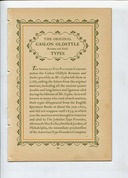
130-137: Caslon Oldstyle No. 471
Caslon Oldstyle No. 471. Caslon Oldstyle Italic No. 471. Quaint Characters [ligatures] for Caslon Oldstyle No. 471. Quaint Characters [ligatures] for Caslon Oldstyle Italic No. 471. Swash Characters [ligatures] for Caslon Oldstyle Italic No. 471. (64 Megabytes)
McGrew (p. 63) traces ATF's Caslon Oldstyle No. 471 back through ATF's pre-1897 designation of it as No. 71, then MacKellar, Smiths & Jordan's Original Old Style, then the Johnson Foundry's Old Style, finally to matrices obtained in some manner from the Caslon foundry in England.
Confusingly, Caslon Oldstyle No. 471 is ATF Series No. 50. ATF Series No. 471 is American Caslon Italic.
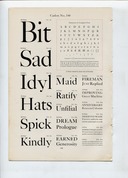
138-145: Caslon No. 540
Caslon No. 540. Caslon Italic No. 540. (65 Megabytes)
McGrew (p. 63) identifies Caslon No. 540 as a version of No. 471 with shortened descenders for standard lining, produced by ATF in response to Inland's Caslon Old Style (1901).
Confusingly, Caslon No. 540 is ATF Series No. 233 and Caslon Italic No. 540 is ATF Series No. 234. ATF Series No. 540 is Graybar Book.
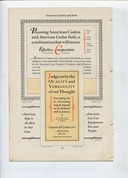
146-153: American Caslon
American Caslon. American Caslon Italic. (64 Megabytes)
McGrew (pp. 67, 69) says that American Caslon is a variation by M.F.Benton of Inland Type Foundry's New Caslon (1905-1906; see below) with "long descenders, oldstyle figures, and italic swash characters."
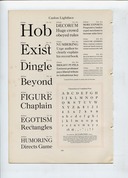
154-161: Caslon Lightface & Bold
Caslon Lightface. Caslon Lightface Italic. Caslon Lightface Condensed. Caslon Bold. Caslon Bold Italic. (50 Megabytes)
McGrew (p. 67) identifies Caslon Lightface as a 1910-1912 recutting of Caslon by Keystone, inherited by ATF. Similarly (p. 71) Caslon Bold was also ex-Keystone (1905ff).
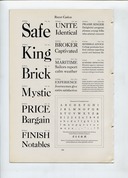
162-169: Recut Caslon
Recut Caslon. Recut Caslon Italic. (74 Megabytes)
McGrew (p. 67) identifies Recut Caslon as Inland Type Foundry (1907).
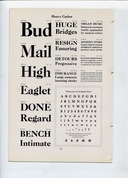
170-173: Heavy Caslon & Bold Condensed
Heavy Caslon. Caslon Bold Condensed Extra Condensed Caslon. (25 Megabytes)
McGrew (p. 73) identifies Heavy Caslon as ex-Inland (1906) and (p. 71) Caslon Bold Condensed as ex-Keystone. I'm probably just missing it, but I cannot find Extra Condensed Caslon in McGrew, either in his discussion of Caslon or his index of ATF series numbers.
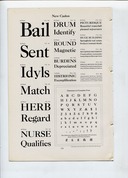
174-177: New Caslon
New Caslon. New Caslon Italic. (25 Megabytes)
McGrew (p. 67) identifies New Caslon as Inland (1905) cut to standard lining with shortened descenders; it was reworked by Benton into American Caslon (see above).

178-181: Caslon Adbold; Bold Extended
Caslon Adbold. Caslon Adbold Extended. Caslon Adbold Extra Condensed. Caslon Bold Extended. (25 Megabytes)
McGrew (p. 71) identifies Caslon Adbold as Keystone (1913). Caslon Bold (see above) was also Keystone (Bold in 1905, Bold Extended 1911).
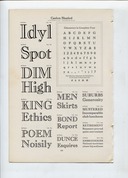
182-189: Caslon Shaded
Caslon Shaded. Caslon Openface. (57 Megabytes)
McGrew (p. 73) identifies Caslon Shaded as an adaptation ("W. F. Capitaine" [sic; "Capitain" is correct as per Saxe), 1917) of Heavy Caslon (see above) and Caslon Openface as ex-BB&S College Oldstyle (1915).
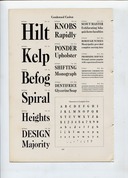
190-191: Condensed Caslon
Condensed Caslon. Shown with New Caslon. (13 Megabytes)
McGrew (p. 69) identifies Condensed Caslon as ex-Inland (1907), as a modification of their New Caslon (see above).

192-211: Century Family
Century Oldstyle. Century Oldstyle Italic. Century Oldstyle Bold. Century Oldstyle Bold Italic. Century Oldstyle Bold Condensed. Century Schoolbook. Century Expanded. Century Expanded Italic. Century Bold. Century Bold Italic. Century Bold Condensed. Century Bold Extended. Century Catalogue. Century Catalogue Italic. (124 Megabytes)

212-217: John Hancock
John Hancock. John Hancock Condensed. John Hancock Extended. (38 Megabytes)

218-229: Clearface Family
Clearface. Clearface Italic. Clearface Bold. Clearface Bold Italic. Clearface Heavy. Clearface Heavy Italic. (86 Megabytes)

246-251: Litho
Light Litho. Card Light Litho [titling]. Condensed Litho. Litho Roman. Bold Litho. Card Litho [titling]. (34 Megabytes)

252-255: Scotch Roman
Scotch Roman. Scotch Roman Italic [sic]. (25 Megabytes)
A statement of the edition size slipped in.
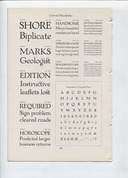
292-297: Colwell Handletter
Colwell Handletter. Colwell Handletter Italic. (36 Megabytes)
Yes, I disbound this copy to scan it. The binding of this particular copy was already failing when I acquired it. One consequence of the choice of this copy for scanning based on the state of its binding is that although the pages of this copy are in good condition, they are not in fine or even near-fine condition.
The PDFs here are just "containers" for 600 dpi RGB JPEG images, but I've used PDF even for single pages (vs. just presenting the image) because the tools for viewing PDFs online are, typically, a bit better than those for viewing JPEGs.
I'm scanning the original at 600dpi RGB and saving losslessly as PNG images. These are too large to present online given 2012 network technology outside of the big cities. If for some reason you really have a need for them, let me know. I'm not sure that they'd be useful, though. The JPEGs inside the PDFs, though lossy versions, are more than sufficient for ordinary use. (You can extract the images themselves using a program such as pdfimages under Linux.) If you're attempting some extraordinary use, you probably want to obtain an original copy of this work and either scan it at much higher resolution or work with it in analog optics.
The 1923 ATF Specimen Book was copyright 1923 by ATF, but copyright was not renewed as would then have been required to secure its continuance. It therefore passed into the public domain upon the expiration of its initial copyright. The reprints from it here remain in the public domain.
All portions of this document not noted otherwise are Copyright © 2011-2012 by David M. MacMillan and Rollande Krandall.
Circuitous Root is a Registered Trademark of David M. MacMillan and Rollande Krandall.
This work is licensed under the Creative Commons "Attribution - ShareAlike" license. See http://creativecommons.org/licenses/by-sa/3.0/ for its terms.
Presented originally by Circuitous Root®
Select Resolution: 0 [other resolutions temporarily disabled due to lack of disk space]